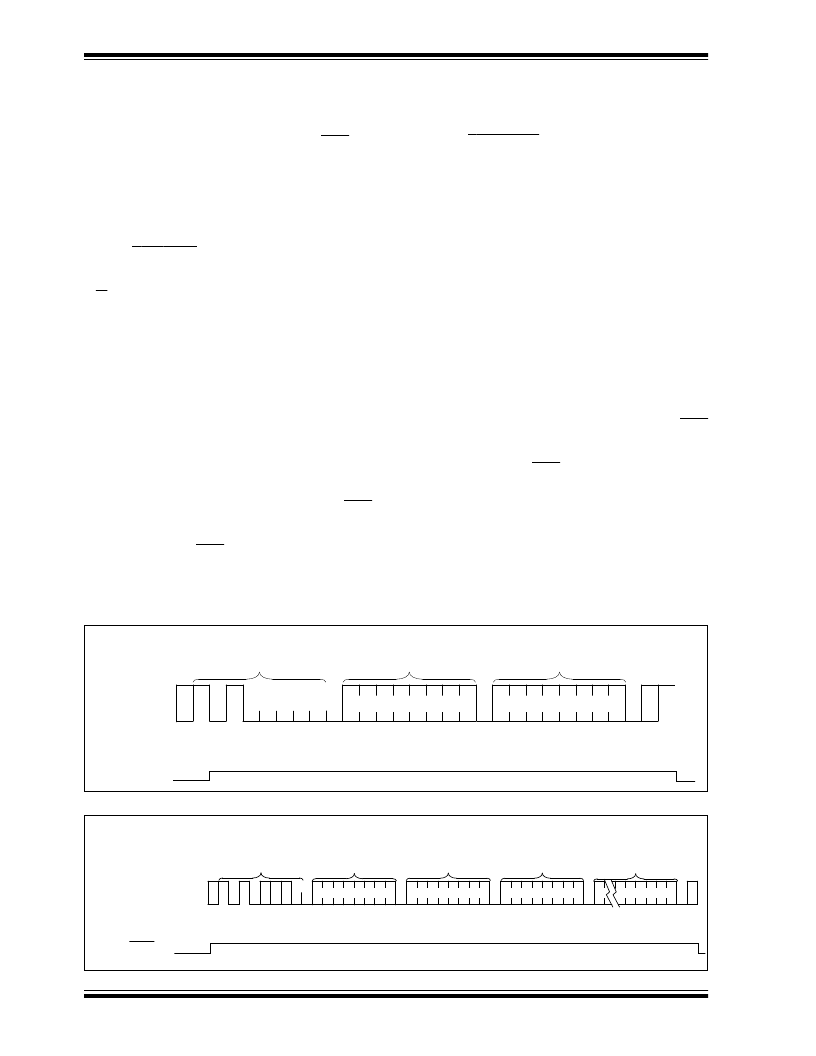- 您現(xiàn)在的位置:買(mǎi)賣(mài)IC網(wǎng) > PDF目錄371399 > 24LC41-IP (Microchip Technology Inc.) 1K/4K 2.5V Dual Mode, Dual Port I 2 C Serial EEPROM PDF資料下載
參數(shù)資料
| 型號(hào): | 24LC41-IP |
| 廠(chǎng)商: | Microchip Technology Inc. |
| 英文描述: | 1K/4K 2.5V Dual Mode, Dual Port I 2 C Serial EEPROM |
| 中文描述: | 1K/4K 2.5V的雙模式,雙端口的I 2 C串行EEPROM |
| 文件頁(yè)數(shù): | 8/12頁(yè) |
| 文件大小: | 98K |
| 代理商: | 24LC41-IP |

24LC41
DS21140B-page 8
1996 Microchip Technology Inc.
4.0
WRITE OPERATION
Write operations are identical for the DDC Monitor Port
(when in bi-directional Mode) and the Microcontroller
Access Port, with the exception of the VCLK/DWP and
MWP pins noted in the next sections. Data can be writ-
ten using either a byte write or page write command.
Write commands for the DDC Monitor Port and the
Microcontroller Access Port are completely indepen-
dent of one another.
4.1
Byte Write
Following the start signal from the master, the slave
address (4-bits), the chip select bits (3-bits) and the
R/W bit which is a logic low is placed onto the bus by
the master transmitter. This indicates to the addressed
slave receiver that a byte with a word address will follow
after it has generated an acknowledge bit during the
ninth clock cycle. Therefore, the next byte transmitted
by the master is the word address and will be written
into the address pointer of the port. After receiving
another acknowledge signal from the port, the master
device will transmit the data word to be written into the
addressed memory location. The port acknowledges
again and the master generates a stop condition. This
initiates the internal write cycle, and during this time,
the port will not generate acknowledge signals
(Figure 4-1).
For the DDC Monitor Port it is required that VCLK/DWP
be held at a logic high level in order to program the
device. This applies to byte write and page write opera-
tion. Note that VCLK/DWP can go low while the device
is in its self-timed program operation and not affect pro-
gramming.
For the Microcontroller Access Port, the MWP pin must
be held to V
SS
during the entire write operation.
4.2
Page Write
The write control byte, word address, and the first data
byte are transmitted to the port in the same way as in a
byte write. But, instead of generating a stop condition,
the master transmits up to eight data bytes to the DDC
Monitor Port or 16 bytes to the Microcontroller Access
Port, which are temporarily stored in the on-chip page
buffer and will be written into the memory after the mas-
ter has transmitted a stop condition. After the receipt of
each word, the three lower order address pointer bits
are internally incremented by one. The higher order 5-
bits of the word address remains constant. If the master
should transmit more than eight words to the DDC Mon-
itor Port or 16 words to the Microcontroller Access Port
prior to generating the stop condition, the address
counter will roll over and the previously received data
will be overwritten. As with the byte write operation,
once the stop condition is received an internal write
cycle will begin (Figure 4-2).
For the DDC Monitor Port, it is required thatVCLK/DWP
be held at a logic high level in order to program the
device. This applies to byte write and page write opera-
tion. Note that VCLK/DWP can go low while the device
is in its self-timed program operation and not affect pro-
gramming.
For the Microcontroller Access Port, the MWP pin must
be held to V
SS
during the entire write operation.
FIGURE 4-1:
BYTE WRITE
S
T
A
R
T
FIGURE 4-2:
PAGE WRITE
S
T
A
R
T
S
P
S
T
O
P
BUS ACTIVITY
MASTER
SDA or
MSDA LINE
BUS ACTIVITY
A
C
K
A
C
K
A
C
K
CONTROL
BYTE
WORD
ADDRESS
DATA
VCLK
S
P
BUS ACTIVITY
MASTER
SDA LINE
BUS ACTIVITY
CONTROL
BYTE
WORD
ADDRESS (n)
DATA n
DATA n + 15
S
T
O
P
A
C
K
A
C
K
A
C
K
A
C
K
A
C
K
DATA n + 1
VCLK/DWP
相關(guān)PDF資料 |
PDF描述 |
|---|---|
| 24LC41-P | 1K/4K 2.5V Dual Mode, Dual Port I 2 C Serial EEPROM |
| 24LC61-IP | 1K/2K Software Addressable I 2 C ⑩ Serial EEPROM |
| 24LCS61 | 1K/2K Software Addressable I 2 C ⑩ Serial EEPROM |
| 24LCS62 | 1K/2K Software Addressable I 2 C ⑩ Serial EEPROM |
| 24LC62-SN | BOX SHIELD W/CVR 2.25X1.38X1.13,1 |
相關(guān)代理商/技術(shù)參數(shù) |
參數(shù)描述 |
|---|---|
| 24LC512/S16K | 制造商:Microchip Technology Inc 功能描述:512K, 64K X 8, 2.5V SER EE,IND - Gel-pak, waffle pack, wafer, diced wafer on film |
| 24LC512/W16K | 制造商:Microchip Technology Inc 功能描述:512K, 64K X 8, 2.5V SER EE,IND,WAFER - Gel-pak, waffle pack, wafer, diced wafer on film |
| 24LC512/WF16K | 制造商:Microchip Technology Inc 功能描述:512K, 64K X 8, 2.5V SER EE,IND - Gel-pak, waffle pack, wafer, diced wafer on film |
| 24LC512-E/MF | 功能描述:電可擦除可編程只讀存儲(chǔ)器 64kx8 - 2.5V RoHS:否 制造商:Atmel 存儲(chǔ)容量:2 Kbit 組織:256 B x 8 數(shù)據(jù)保留:100 yr 最大時(shí)鐘頻率:1000 KHz 最大工作電流:6 uA 工作電源電壓:1.7 V to 5.5 V 最大工作溫度:+ 85 C 安裝風(fēng)格:SMD/SMT 封裝 / 箱體:SOIC-8 |
| 24LC512-E/MS | 制造商:Microchip Technology Inc 功能描述:512K, 64K X 8, 2.5V SER EE, EXT - Rail/Tube 制造商:Microchip Technology Inc 功能描述:IC EEPROM 512KBIT 400KHZ 8MSOP 制造商:Microchip Technology Inc 功能描述:512K, 64K X 8, 2.5V SER EE, EXT, 8 MSOP 3x3mm TUBE |
發(fā)布緊急采購(gòu),3分鐘左右您將得到回復(fù)。